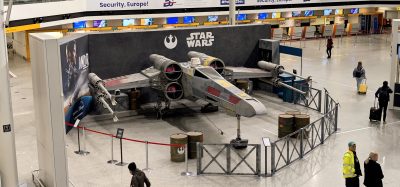Economic decline but airport growth
- Like
- Digg
- Del
- Tumblr
- VKontakte
- Buffer
- Love This
- Odnoklassniki
- Meneame
- Blogger
- Amazon
- Yahoo Mail
- Gmail
- AOL
- Newsvine
- HackerNews
- Evernote
- MySpace
- Mail.ru
- Viadeo
- Line
- Comments
- Yummly
- SMS
- Viber
- Telegram
- Subscribe
- Skype
- Facebook Messenger
- Kakao
- LiveJournal
- Yammer
- Edgar
- Fintel
- Mix
- Instapaper
- Copy Link
Posted: 29 March 2012 | Vincent Harrison, Director of Strategy at the Dublin Airport Authority | No comments yet
Traffic at Dublin Airport Authority’s three Irish airports returned to overall growth last year, as a jump in inbound travellers more than offset continued weakness in outgoing trips.
More than 22.7 million passengers used Dublin, Cork and Shannon airports during 2011, an increase of one per cent. Dublin Airport was DAA’s best performer last year with passenger traffic increasing by two per cent to 18.7 million passengers. Excluding domestic air travel within the Irish Republic, which has declined due to domestic economic factors and a much improved road network, international passenger numbers were up two per cent across the group and by three per cent at Dublin.
Economic conditions remain the main driver of air travel and as the Irish economy contracted from 2008 passenger numbers declined, just as they had enjoyed double digit growth during the period of economic expansion.
Dublin Airport’s traffic, for example, is still almost 40 per cent higher than it was in the year 2000, which equates to an extra five million passengers over the past 11 years, despite the recent slowdown.
Traffic at Dublin Airport Authority’s three Irish airports returned to overall growth last year, as a jump in inbound travellers more than offset continued weakness in outgoing trips.
More than 22.7 million passengers used Dublin, Cork and Shannon airports during 2011, an increase of one per cent. Dublin Airport was DAA’s best performer last year with passenger traffic increasing by two per cent to 18.7 million passengers. Excluding domestic air travel within the Irish Republic, which has declined due to domestic economic factors and a much improved road network, international passenger numbers were up two per cent across the group and by three per cent at Dublin.
Economic conditions remain the main driver of air travel and as the Irish economy contracted from 2008 passenger numbers declined, just as they had enjoyed double digit growth during the period of economic expansion.
Dublin Airport’s traffic, for example, is still almost 40 per cent higher than it was in the year 2000, which equates to an extra five million passengers over the past 11 years, despite the recent slowdown.
The stabilisation in passenger numbers that we saw last year reflects the improved performance by the Irish economy and the economies of some of our key trading partners. Clearly the ongoing Euro crisis and the high price of oil gives cause for concern, however we remain cautiously optimistic about the short-term prospects and very positive about the longterm prospects for traffic growth.
The Irish economy is expected to outperform its EU counterparts over the next few years, driven by a strong export sector. Ireland continues to attract significant levels of foreign direct investment, particularly from the United States. US investment in Ireland is worth more than US investment in the economies of Brazil, Russia, India, and China combined. Ireland is home to eight of the top 10 global technology companies and eight of the world’s 10 largest pharmaceutical firms.
Ireland also has a fantastic tourism product. Visitor numbers were up eight per cent last year, and we expect further growth from the tourism sector over the medium term. That growth will be further stimulated in 2013 by The Gathering, a year-long series of events aimed at specifically encouraging those people with Irish heritage to visit Ireland by inviting them to come and join the celebration of all things Irish during the year.
While travel overseas by Irish people has declined in recent years due to changed economic circumstances, the Irish continue to travel by air more frequently than their neighbours. Irish residents take twice as many flights as British residents and four times as many as those living in continental Europe.
As an island nation, with no land link to Europe, it is perhaps not surprising that we fly far more than our peers, but this data underscores the strong demand for air services into and out of Ireland. Dublin-London, for example, remains Europe’s busiest international route-and the fourth busiest international route in the world with about 3.5 million people travelling between the two cities every year.
Across the three airports, DAA stimulates new routes through a series of generous incentive schemes that offer discounts against our highly competitive airport charges. Qualifying new short and long-haul routes receive a 100 per cent discount on airport charges in their first year of operation and targeted marketing support is also available. DAA also rewards the retention of traffic at its three airports, with a growth incentive scheme that rebates passenger charges once traffic surpasses the previous year’s baseline.
Earlier this year, Dublin Airport paid €1.5 million in rebates to 30 different airlines that grew their business during 2011. Among the list of airlines that received rebates were Aer Arann, Aer Lingus, Etihad Airways, Lufthansa, Norwegian, SAS, Swiss, Turkish Airlines and US Airways. The Growth scheme is in place at Dublin, Cork and Shannon airports for this year and for 2013.
Incentives such as these are just one way that DAA encourages airlines to expand from its Irish airports. We maintain close contact with both existing and prospective new customers on a regular basis sharing our market insights and research with them. We also work closely with Tourism Ireland, which has the responsibility for marketing Ireland as a tourist destination overseas.
These relationships can sometimes take time to deliver, but even when carriers say not yet, or we do not have the capacity at present, we maintain our contact and continue to educate them about the huge potential in Ireland.
Emirates Airline is a case in point. We had been talking to them for almost a decade before they announced their decision to begin a Dublin- Dubai service from January of this year.
While some commentators expressed surprise at Emirates choosing to enter the Irish market at this point, Emirates’ President Tim Clark said it was more surprising that they hadn’t done so before. Having arrived in Dublin on the inaugural flight, Clark told the media that “Ireland has an enormous amount to offer, it’s a fantastic place to come.” Emirates was “looking at a route that could turn the corner within the next six months….it’s a very good story,” he said.
Just how good the Irish story was for Emirates became clear just three weeks after the route’s launch when the airline announced that it would shortly be increasing capacity on Dublin- Dubai by 52 per cent through the use of a larger Boeing 777-300ER on the route. Dublin-Dubai has been one of Emirates’ most successful launches in any market and the airline’s fastest ever capacity expansion on a new route.
One of the key reasons for any airline to opt for Dublin is the significant improvement in new facilities at the airport that we have made in recent years. We invested €1.2 billion in our transforming Dublin Airport programme between 2005 and 2011, delivering a host of new and improved facilities for passengers and airlines including an award-winning new passenger terminal, two new boarding gate piers, an extension to Terminal 1, new taxiways and aircraft parking stands, a new campus road network, new car parks, and a major upgrade to the airport’s energy, water and communications networks.
This has delivered a vast improvement in service levels across both terminals at Dublin Airport, and this has been recognised by our customers. In the most recent ACI Airport Service Quality (ASQ) study, for the fourth quarter of 2011, Dublin was in third position out of 29 European airports handling between five and 25 million passengers per year. In the same study five years ago, Dublin was at the bottom of the table of European airports.
The ASQ study is based on face-to-face interviews with passengers at airports across Europe and measures travellers’ opinions and experiences across a wide range of areas including; overall satisfaction with the airport, cleanliness, courtesy and helpfulness of staff, security queuing times, ease of finding their way around the airport and comfort levels at departure gates. We will continue to strive to improve our customer service to both passengers and airlines alike in the months and years ahead.
We have also been investing in Cork and Shannon to improve the passenger experience at both airports. One service offering that is unique in Europe is the facility for United States bound passengers at Dublin or Shannon airports to avail of US Customs & Border Protection (CBP) preclearance. This allows passengers to clear all American immigration, customs and agricultural checks prior to departure.
Flights using CBP arrive as domestic in the US, meaning that carriers can land at cheaper domestic gates or indeed at domestic airports if they so choose. The first queue they will encounter upon arrival in the US will be for a taxi or a bus outside the terminal. Ireland is the only country outside North America and the Caribbean to offer this facility to passengers.
The improved facilities at Dublin including T2 and CBP saw US Airways launch a new route to Charlotte NC last year, and later this year United will begin a new Dublin-Washington DC service.
A total of 10 new routes have already been unveiled from Dublin this year, with new services from Aer Lingus, Aer Lingus Regional, Emirates, Ryanair, Lufthansa, and United. Our airline customers are also expanding 17 existing services out of Dublin. Five new routes have been announced for Cork and Shannon Airports – operated by Aer Lingus, Aer Lingus Regional and Ryanair – and Aer Lingus and Aer Lingus Regional is also adding capacity to some existing services at those two airports.
Understandably, attention in Ireland and overseas has focused on the impact of the recent economic downturn. Notwithstanding the continuing uncertainty across Europe, 2011 saw a return to growth for our airports in Ireland and heralds cautious optimism for a stronger recovery in the near term.
DAA is well positioned to take advantage of this upturn, as Dublin, Cork and Shannon airports have competitive charges and generous incentive schemes aimed at sharing the risk of launching a new route with our airline customers. We have also put in place new and improved facilities thatoffer passengers a radically improved travel experience and provide a robust platform for future growth.
About the author
Vincent Harrison is of Director Strategy, Regulation & B2B with Dublin Airport Authority (DAA). He has responsibility for aeronautical business development and mark – eting activities for the three Irish airports owned and operated by DAA.
Vincent has previously held senior financial and management positions with Esat/BT in Ireland and with Rubbermaid in USA and in Europe. He has also worked as an independent management consultant.
A graduate of University College Cork, Vincent holds an MBA degree from University of Pittsburgh, USA, and is a Fellow of the Institute of Chartered Accountants in Ireland. He trained and qualified as a Chartered Accountant with Arthur Andersen in Dublin.


















